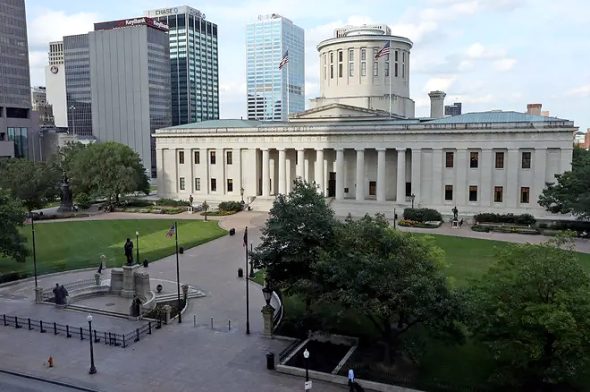
The Ohio Statehouse in Columbus. Photo courtesy of Brooke LaValley, The Columbus Dispatch.
YS Schools join statewide voucher lawsuit
- Published: February 8, 2025
In early January, Ohio House Speaker Matt Huffman spoke to the press about his intention to support cutting state funding to Ohio’s public schools in this year’s two-year overall budget, stating that “increases in spending are unsustainable.”
“We have to look at whether these dollars are spent wisely,” Huffman told a reporter.
Public schools in Ohio are funded in part by state tax monies, but largely by local property tax levies — and the way public schools spend their money is overseen and heavily regulated by the Ohio Department of Education and Workforce, or ODEW.
Due to expansions in the state’s EdChoice school voucher program, chartered private schools in Ohio are now also eligible to receive state tax funding on a per-student basis. However, private schools — though still subject to some regulations from ODEW — are not as heavily regulated as public schools. Many of the private chartered schools that receive voucher funding are religious schools.
That’s unconstitutional, says Vouchers Hurt Ohio, a coalition of about 300 Ohio public school districts — nearly half of the state’s 611 districts — that aims to curtail the state’s funding of private schools via tax dollars.
Yellow Springs Schools is one of the districts that has joined the growing coalition as it works to bring a lawsuit against the state — a lawsuit that questions the wisdom, and the fairness, of using public dollars to pay for private school tuition.
A brief history of EdChoice
Ohio’s EdChoice program was established in 2005, ostensibly to provide scholarships — also known as vouchers — to students in public schools that were designated as “underperforming.”
The program, in its initial formulation, provided a portion of tuition funding through vouchers to enable students in districts identified as underperforming to attend chartered private schools — that is, nonpublic schools receiving a state charter via adherence to Ohio Administrative Code Chapter 3301-35, “Standards for Kindergarten through Twelfth Grade.” At the time, students already enrolled in private schools were not eligible to receive EdChoice vouchers.
In 2013, ODEW — then known only as the Ohio Department of Education — expanded the EdChoice program, opening voucher access to a wider group of students, with new eligibility based on a family income level below 200% of the federal poverty level, regardless of school district performance. Four years later, the income eligibility requirement was increased to 250% of the federal poverty level.
The Universal EdChoice expansion in 2023 brought the program roughly to where it is now, with its income requirement rising to up to 450% of the federal poverty level for scholarship amounts of up to $6,165 for students in grades K–8 and up to $8,405 for high school students. Families whose income is above the 450% threshold may still receive vouchers on a sliding scale, making the EdChoice program accessible on a “universal” level to virtually any family in Ohio. Unlike in 2005, vouchers are now open to students already enrolled in private schools.
Ohio spent $970.7 million in funding a variety of private school vouchers in fiscal year 2024, according to data from ODEW reported in Ohio Capital Journal; $406.7 million of that total went to EdChoice expansion vouchers. The state’s total amount spent on primary and secondary education in fiscal year 2024 was $13 billion.
Vouchers Hurt Ohio’s case
The Vouchers Hurt Ohio coalition’s website lays out five counts in its pending case against the state, charging that the current model for EdChoice vouchers is unconstitutional:
• That funding for EdChoice vouchers comes from “the same line-item in the two-year state budget that funds public schools. Each public tax dollar that goes to private schools is a dollar less for public schools”;
• That private school vouchers “force local school districts to raise local taxes through levies to make up the reduction in state dollars”;
• That private school vouchers make “segregation in public schools worse,” with private schools taking “public tax dollars while applying litmus tests to pick and choose their students”;
• Citing the Ohio Constitution and referring to the preponderance of religious-based private schools, that “no religious or other other sect shall every have any exclusive right to or control of any part of the school funds of the state”;
• And that, if Vouchers Hurt Ohio’s lawsuit is successful, “lawmakers will not be permitted to fund the harmful private school voucher program or any other separate, but unequal system of schools.”
William L. Phillis, executive director of the Ohio Coalition for Equity and Adequacy of School Funding, which is spearheading Vouchers Hurt Ohio’s pending legal action, spoke with the News this week. He said the coalition’s lawsuit challenging the constitutionality of the voucher program was filed in 2022 and originally set to go to trial in November 2024; the trial was pushed back because of a delay in summary judgments to the case, which are set to be made in April in a pretrial hearing. The actual trial date for the lawsuit has yet to be set.
Phillis said he believes every Ohioan should be concerned about the voucher program, because it affects the state taxes everyone pays.
“Most of the people going to those private operations are going to religious schools,” he said, noting that around 90% of EdChoice expansion vouchers are used for students attending religious — mostly Catholic — schools.
“Taxpayers are subsidizing these various religious doctrines, which is clearly unconstitutional,” Phillis said. “Every dime that a public school spends is audited by the state auditor, but there’s no state audit in a private school. There’s no requirement that private schools share any of their financial information or curriculum [with the public]. They’re not subject to public records requests. We don’t know who’s governing those groups. What we do know is the taxpayers are not entitled to any information about them and are essentially signing a blank check.”
The Ohio Coalition for Equity and Adequacy of School Funding has successfully brought legal action against the state over inequities in school funding in the past. They were behind the landmark 1997 case DeRolph v. State of Ohio, in which the Ohio Supreme Court ruled that the state’s reliance on local property taxes created a disparity between school districts, and that the state had failed to meet its constitutional obligation to provide a “thorough and efficient system of common schools.”
The state was ordered by the Ohio Supreme Court to reform its school funding model, which resulted in the Cupp-Paterson Fair Schools Funding Plan. The plan is intended, in part, to direct more state funding to school districts with less capacity for local property tax revenue — but it has yet to be fully funded, and is currently in the third stage of its planned six-year roll-out.
DeRolph v. State of Ohio was a six-year effort, and Phillis told the News he expects Vouchers Hurt Ohio’s lawsuit will likely also be a “multiyear process.” He added that, unlike with DeRolph v. State of Ohio, he believes a ruling in favor of Vouchers Hurt Ohio’s case won’t result in reform, but the end of the private school voucher program altogether.
“In this case, we’re challenging the constitutionality of the very voucher scheme itself,” Phillis said. “If they rule that vouchers are unconstitutional, that means they can’t fund the vouchers anymore. That’s what we’re after — to get the program declared unconstitutional and defunded.”
Local impact of vouchers
The News reported in 2022 that there were no local students receiving vouchers through EdChoice, though two had signed up for the program the year before. According to data supplied to the News from the ODEW, in fiscal year 2024 — after the rollout of the EdChoice expansion into universal voucher availability — 11 local students received vouchers through the program.
Enrollment data for YS Schools for the last several years does not show a correlation between the number of students attending the public schools and those receiving EdChoice vouchers; it’s likely that those who received vouchers in fiscal year 2024 were already attending chartered private schools. Following the EdChoice expansion, only about 3,000 students statewide made the move from public to private schools.
The News spoke last week with a Miami Valley public school district treasurer, who asked not to be named. The treasurer said the direct impact on local school districts is difficult to quantify in terms of dollars and cents.
“It isn’t really that state vouchers cause losses for public schools, because it didn’t really change people’s decision on whether or not to send their kids to private school,” the treasurer said.
Yellow Springs Schools receives per-student funding from the state, and the funding for EdChoice vouchers comes from the state’s budget, not the local school district’s. But the treasurer pointed out that the less money the state gives to public schools, the more money districts must ask local property owners to pay via levies.
“It places an undue burden on taxpayers; it’s money that could go to public schools but doesn’t, and the money [districts] receive has to come from somewhere,” the treasurer said.
Yellow Springs school board member Dorothée Bouquet — who brought the village district’s participation in the Vouchers Hurt Ohio lawsuit into the public eye during a Jan. 9 board meeting — also spoke with the News last week. Noting that she was not speaking on behalf of the school board, Bouquet said that state funding currently accounts for 25% of the district’s overall budget annually. Bouquet said it’s “hard to identify how much money the schools have been losing” since the expansion of EdChoice, but she recalled Ohio House Speaker Matt Huffman’s comments early this year.
“This year, the Legislature is going to decide on the budget for the whole state for the next two years,” Bouquet said. “[Huffman] has already hinted that he’s going to slash that down. … If we translate that into the impact on Yellow Springs, it’s that the local burden on taxpayers is going to increase.”
For that reason, Bouquet said she hopes to have the school district write a letter to legislators, which could then be co-signed by other locals who are critical of Huffman’s comments and the universal voucher program. The state’s budget will be set soon, Bouquet said, so the time to speak out is now.
“There is a limited window of opportunity here where taxpayers can be loud in their writing and communicating with legislators to say, ‘We see what you’re preparing to do, and this is not OK,’” she said.
The News plans to continue following the Vouchers Hurt Ohio lawsuit as it progresses.
The Yellow Springs News encourages respectful discussion of this article.
You must login to post a comment.
Don't have a login? Register for a free YSNews.com account.















No comments yet for this article.